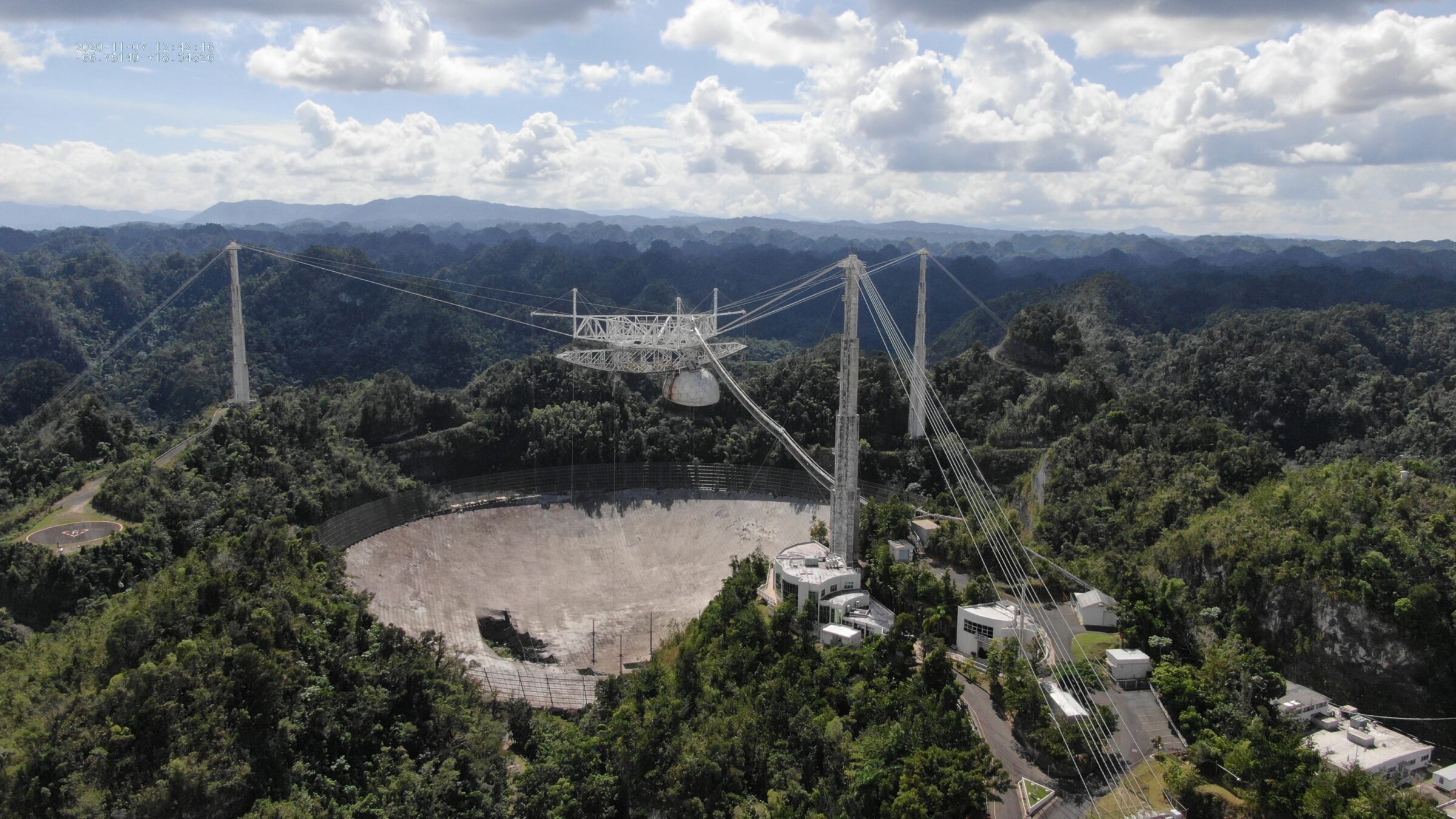Jason Davis • Nov 24, 2020
Planetary Society Reacts to Loss of Arecibo Observatory Radio Telescope
The Arecibo Observatory radio telescope will soon be no more. The iconic dish built into a Puerto Rican tropical forest is on the brink of collapse due to a series of support cable failures. It cannot be safely repaired and must be decommissioned, the National Science Foundation says. The Planetary Society mourns the loss of the observatory, celebrates its achievements, and expresses concern that there is no direct replacement for its unique capabilities.
Popularized in movies like Contact and GoldenEye, Arecibo was the largest full-dish telescope in the world from 1963 to 2016. Boasting a width of 300 meters (1,000 feet), the observatory was responsible for numerous scientific achievements. In addition to a wide range of astronomical discoveries, Arecibo found the first known exoplanet and created maps of water ice inside Mercury’s permanently shadowed craters. Its powerful radar could reveal the shape of near-Earth asteroids and provide detailed orbital information to determine whether such asteroids posed a threat to our planet. The observatory also searched for signals from intelligent life on other worlds, both directly and by piggybacking on other scientific observations.
“Arecibo has been a unique multidisciplinary tool that helped us explore the cosmos and our solar system, search for life, and defend Earth from potentially dangerous asteroids,” said Planetary Society chief operating officer Jennifer Vaughn. “We are saddened over the telescope’s loss and support the science community as they evaluate the impact of losing Arecibo’s capabilities.”

📻 Hear More on Planetary Radio
Our 2 December episode of Planetary Radio will feature an exclusive interview with Arecibo Observatory director Francisco Córdova.
Of immediate concern is the telescope’s role in tracking and characterizing asteroids. Arecibo’s planetary radar was the most powerful in the world, observing roughly 100 near-Earth asteroids per year. Half of those were newly discovered objects whose orbits were not precisely known. Arecibo observations helped scientists determine whether an asteroid would hit our planet and ensured their trajectories were catalogued for future observations.
Although Arecibo’s 300-meter fixed dish—a series of aluminum panels supported by a mesh of steel wire—limited the amount of sky it could see at any given time, its sheer size allowed it to reveal details on asteroids less than a kilometer wide. NASA, which funded Arecibo’s planetary radar program, will now have to rely solely on the weaker radar transmissions from a 70-meter telescope at its Goldstone observatory in California. Goldstone’s radar transmissions can be received at the Green Bank Telescope in West Virginia, the Very Large Array in New Mexico, and at Goldstone itself. Its steerable dish can track asteroids over a larger portion of the sky than Arecibo, but Arecibo’s size allowed it to reach farther asteroids. Having two planetary radars also provided a backup in case one experienced a hardware failure.
“Arecibo’s ability to characterize near-Earth objects using radar was a real asset for the planetary defense community,” said Planetary Society chief scientist Bruce Betts. “Arecibo offered increased range for near-Earth asteroid observations and provided an excellent complement to Goldstone radar observations.”

Over the past decade, Arecibo has faced a series of financial and environmental setbacks. Management of the facility changed hands twice, ending up with a consortium led by the University of Central Florida. The National Science Foundation began reducing its financial contribution to Arecibo in 2017. Earthquakes have recently struck the facility on more than one occasion, and Hurricane Maria damaged Arecibo when the storm devastated Puerto Rico in 2017.
The latter events may have contributed to Arecibo’s demise. An auxiliary cable supporting the instrument dome above the dish slipped from its socket in August 2020, ripping a 30-meter-wide hole in the dish. As engineers prepared a fix, a main cable on the same tower broke. Inspections revealed problems in other cables, and the observatory’s engineering contractor concluded repairs could not be safely implemented.

The Planetary Society’s connections to Arecibo include SETI, the search for extraterrestrial intelligence. In 1981, NASA and the Society teamed up to fund Suitcase SETI, a portable spectrum analyzer that could be installed on large radio telescopes like Arecibo. The project spurred numerous other Society SETI efforts, including SERENDIP, a collaboration with NASA, the National Science Foundation, and the University of California, Berkeley to look for SETI signals within unrelated astronomical observations at Arecibo and other observatories. SERENDIP data was eventually funneled into SETI@home, a popular computer program that allowed citizens around the world to look for SETI signals using spare computing power. The Planetary Society provided the project’s initial seed funding.
Arecibo Observatory plays a role in Contact, the 1985 novel by Planetary Society co-founder Carl Sagan about a scientist who finds a message from extraterrestrial beings inside radio signals. The novel is based on a screenplay between Sagan and Ann Druyan and was adapted into a 1997 movie starring Jodie Foster.
The Planetary Society is following the situation as the scientific community explores its options to replace Arecibo’s capabilities. Any further activities at the telescope itself must prioritize the health and safety of engineers, scientists, and technicians.
The Time is Now.
As a Planetary Defender, you’re part of our mission to decrease the risk of Earth being hit by an asteroid or comet.
Donate Today

 Explore Worlds
Explore Worlds Find Life
Find Life Defend Earth
Defend Earth

